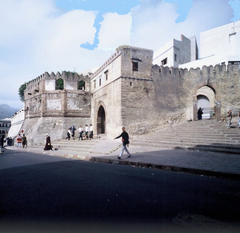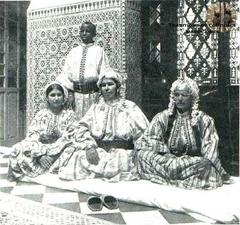Bab Jiaf Visiting Hours, Tickets, and Historical Sites in Tétouan, Morocco
Date: 14/06/2025
Introduction
Nestled in the Rif Mountains of northern Morocco, Tétouan’s medina stands as a living testament to centuries of cultural exchange and architectural excellence. Recognized as a UNESCO World Heritage Site since 1997, the medina is renowned for its harmonious blend of Andalusian, Berber, Jewish, and Spanish influences. At the heart of this historic urban landscape is Bab Jiaf, one of the medina’s seven principal gates. More than just an entryway, Bab Jiaf represents the city’s multicultural narrative, social traditions, and artisanal lifeblood.
This comprehensive guide delves into the history, architecture, and significance of Bab Jiaf, providing practical information on visiting hours, ticketing, accessibility, and nearby attractions. Whether you are a history enthusiast or a first-time visitor, this article equips you to explore Tétouan’s vibrant heritage authentically and respectfully.
For further planning, consult resources such as the UNESCO World Heritage site, the Official Tétouan Tourism Website, and travel insights from The Right Voyage.
Table of Contents
- Introduction
- Ancient Foundations and Early Influences
- The Andalusian Legacy and Urban Fabric
- Bab Jiaf: History, Architecture, and Visitor Information
- Multicultural Tapestry: Jewish, Berber, and Spanish Heritage
- Fortifications and the Seven Gates
- Artistic and Craft Traditions
- Religious and Social Landmarks
- Visiting Tétouan’s Historical Sites: Practical Information
- Tétouan’s Role in Moroccan Nationalism and Modern Identity
- Preservation and Contemporary Significance
- Frequently Asked Questions (FAQ)
- Conclusion
- References
Ancient Foundations and Early Influences
The roots of Tétouan trace back over two millennia to the Mauretanian Berber settlement of Tamuda, once a Phoenician trading post and later a Roman settlement under Emperor Augustus (UNESCO). By the 13th century, the Marinid dynasty recognized the strategic importance of the site, constructing a casbah and mosque and laying the groundwork for a fortified urban center.
The Andalusian Legacy and Urban Fabric
The late 15th century marked a pivotal era as waves of Muslim and Jewish refugees, expelled from Spain during the Reconquista, rebuilt Tétouan. These Andalusian settlers introduced sophisticated agricultural practices, artisanal crafts, and distinctive whitewashed architecture. Today, Tétouan’s medina is characterized by its labyrinthine street plan, lush gardens, and a unique blend of Moroccan and Andalusian urban design (The Right Voyage). The medina is celebrated as Morocco’s most complete example of this urban heritage.
Bab Jiaf: History, Architecture, and Visitor Information
Historical Significance
Bab Jiaf (also spelled Bab Ejjyafe or Bab El-Jiaf) was constructed in the late 15th or early 16th century as part of the medina’s defensive ramparts (UNESCO). Its name stems from the Arabic “jiaf,” meaning “remains” or “carcasses,” reflecting its historical function as a route for funerary processions and the disposal of animal remains near the adjacent cemeteries (Kurby Blog). The gate is also linked to the city’s tanneries, underscoring its utilitarian role.
Architectural Features
Bab Jiaf is characterized by robust white limestone walls (1.5–2 meters thick) and a classic horseshoe arch, a hallmark of Moorish-Andalusian design (MiuMiu UNESCO Cities). Its double-arched entrance is modest in decoration, emphasizing practicality over grandeur. Defensive features include narrow passageways, original wooden doors reinforced with metal studs, and “murder holes” for observation and defense (Visit Morocco).
Location and Urban Context
Situated on the northern edge of the medina, Bab Jiaf connects to neighborhoods historically associated with artisans and working-class residents. Its proximity to traditional tanneries and the Jewish cemetery highlights its ongoing relevance to urban life (Petit Futé).
Visiting Hours and Tickets
Bab Jiaf is an open-access heritage site with no entrance fee, functioning as a city gate rather than a contained monument. It is generally accessible from sunrise to sunset (7:00 AM–7:00 PM, seasonally). Guided tours covering Bab Jiaf and other medina sites are available through local agencies and may require advance booking (Official Tétouan Tourism Website). There is no ticket required to enter Bab Jiaf.
Accessibility and Visitor Tips
- Foot Access: Bab Jiaf is only accessible on foot; the medina’s narrow, uneven streets require comfortable shoes.
- Mobility Considerations: The historic layout poses challenges for wheelchair users. There is currently no dedicated wheelchair infrastructure.
- Best Times to Visit: Early morning or late afternoon for optimal lighting and fewer crowds.
- Cultural Etiquette: Dress modestly and seek permission before photographing locals, especially during funerary processions or in workshops.
- Safety: The area is generally safe, but remain vigilant in crowded settings and secure your belongings.
Multicultural Tapestry: Jewish, Berber, and Spanish Heritage
Tétouan’s medina is a mosaic of Andalusian, Jewish, and Berber legacies (Wikivoyage). The Jewish cemetery near Bab Jiaf is a notable site, home to thousands of tombstones reflecting five centuries of community presence. Berber influences endure in local settlement patterns and traditions, while Spanish heritage is visible in public architecture and historical gate names.
Fortifications and the Seven Gates
The medina is encircled by a 5-kilometer wall punctuated by seven principal gates, each with distinctive cultural and defensive roles (UNESCO). In addition to Bab Jiaf, gates such as Bab el-Okla and Bab el-Assa are significant landmarks. These fortifications demonstrate Tétouan’s historical need for protection and ceremonial entrances.
Artistic and Craft Traditions
Tétouan’s artisanal traditions thrive in the medina’s souks and workshops. Crafts introduced by Andalusian refugees—woodwork, embroidery, ceramics, leatherwork—are still practiced and taught at institutions like Dar Sanaa and the National Institute of Fine Arts (UNESCO). Visitors can watch artisans at work and purchase handmade goods (Mad Traveller). Music, particularly Andalusian and Gnawa genres, adds to the city’s cultural vibrancy.
Religious and Social Landmarks
- The Grand Mosque (Mosque of the Andalusians): Exemplifies the intersection of Andalusian and Moroccan architectural forms.
- Palace of Sultan Mawlay Abdelhalim: Now a museum, it offers insights into the city’s governance and history.
- Public Squares: Places like Jemaa al-Fna serve as hubs for markets, social gatherings, and cultural performances.
Visiting Tétouan’s Historical Sites: Practical Information
- Guided Tours: Highly recommended for a comprehensive understanding; book in advance.
- Nearby Attractions: The tanners’ souk, Jewish cemetery, and Andalusian gardens are within walking distance.
- Facilities: Public restrooms are scarce in the medina; facilities are available at Feddan Park, museums, or major cafés.
- Language & Currency: Moroccan Darija, Spanish, and French are spoken. Cash is preferred in the medina.
Tétouan’s Role in Moroccan Nationalism and Modern Identity
In the 20th century, Tétouan became a center for Moroccan nationalism, with leaders like Abdelkhalek Torres championing independence. Its multicultural legacy and creative spirit have earned it the title “Jewel of Northern Morocco” and designation as a UNESCO Creative City in Crafts and Folk Art (Moroccan Scene).
Preservation and Contemporary Significance
Since its UNESCO designation, Bab Jiaf and the medina have benefitted from preservation projects to stabilize structures and conserve traditional features (UNESCO). Community involvement and international cooperation ensure that Tétouan’s heritage is respected while adapting to modern urban life.
Surrounding Tétouan Historical Sites Near Bab Jiaf
- Souk El Hout: Vibrant fish market.
- Ghersa K’Bira: Popular flea market near Bab Jiaf.
- Mellah (Jewish Quarter): Area with historic synagogues and markets.
- Artisan and Tanners’ Quarters: Centers for traditional crafts.
- Feddan Park: Offers panoramic views of the city (Revigorate).
- Ethnographic Museum, Dar El Oddi Museum, Archaeological Museum: Cultural and historical exhibitions.
- Spanish Quarter (El Ensanche): Art deco and European architectural influences.
Day Trips and Excursions
- Chefchaouen: The blue-painted mountain town (approx. 60 km away).
- Rif Mountains: Hiking and nature experiences.
- Mediterranean Beaches: Martil, Cabo Negro, and Kabila Beach.
Accommodation and Dining
Stay in traditional riads or modern hotels in the Ville Nouvelle. Enjoy Moroccan and Spanish-influenced cuisine; don’t miss mint tea in a medina café (Wild Trips).
Festivals and Events
Tétouan hosts music, art, and culinary festivals year-round. Check local listings for current programs.
Frequently Asked Questions (FAQ)
Q: What are Bab Jiaf visiting hours?
A: Bab Jiaf is open daily, typically from sunrise to sunset; there are no set closing hours for the gate itself.
Q: Is there an entrance fee or ticket required?
A: No, Bab Jiaf and the medina are freely accessible.
Q: Are guided tours available?
A: Yes, guided walking tours are offered locally and online, many including Bab Jiaf.
Q: Is Bab Jiaf accessible for people with mobility issues?
A: The medina’s narrow and uneven streets can be challenging for visitors with limited mobility.
Q: What nearby attractions are recommended?
A: Tanners’ souk, Jewish cemetery, artisan workshops, and Andalusian gardens.
Q: Where can I find official information?
A: Official Tétouan Tourism Website and UNESCO World Heritage site.
Conclusion
Bab Jiaf is more than a gateway; it is a living symbol of Tétouan’s enduring multicultural identity and vibrant community life. Its understated architecture, historical functions, and proximity to artisan neighborhoods invite visitors to experience the medina’s authentic rhythms. Whether you’re exploring independently or with a guide, Bab Jiaf offers an accessible entry point into Tétouan’s rich tapestry of history, culture, and craftsmanship.
Plan your visit today using trusted resources, and consider downloading the Audiala app for guided tours, maps, and up-to-date event information. Follow us on social media for the latest travel tips and inspiration.
References
- UNESCO World Heritage site
- UNESCO World Heritage site (Bab Jiaf)
- Travelling in Morocco: Discover Tétouan
- Things to Do in Tétouan – Revigorate
- The Right Voyage: Exploring Tétouan
- Petit Futé: Bab Jiaf
- Moroccan Scene: Tétouan
- Mad Traveller: Medina of Tétouan
- MiuMiu UNESCO Cities: Tétouan
- Visit Morocco: Tétouan Travel Guide
- Kurby Blog: Evolution of Tétouan’s Architecture
- Malika in Morocco: Ultimate Guide to Tétouan
- Wild Trips: Top 10 Attractions in Tétouan

